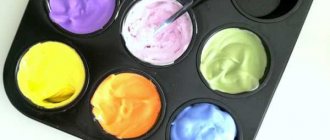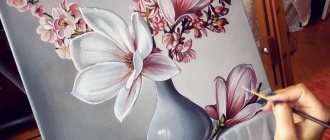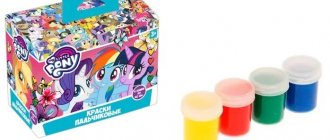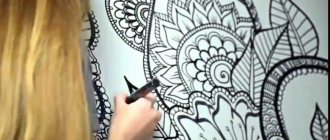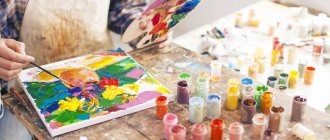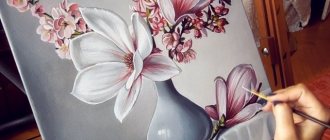Drawing is, one might say, in the blood of children. Absolutely all children love to draw here and there (on the wallpaper, on the table, on the carpet)... But so that the interior does not suffer and your nerves remain intact, the child needs a full-fledged workplace to express his fantasies and emotions. And, of course, the right and safe material for creativity.
The ability to draw is determined by the development of one of the hemispheres of our brain: absolutely all children have developed the right, and only over the years, when the child goes to school and begins to solve logical problems, does the left hemisphere catch up with the right in its development. Well, until this moment, parents must provide the child with space for creative expression.
Today there are quite a lot of materials with which you can draw: different types of paints, felt-tip pens, pencils, crayons, markers... A young mother will be dizzy from such an assortment. But not every material is suitable for a two-year-old. Let's try to figure out what to draw for a 2-3 year old child? What materials exist and which ones are best to choose in terms of safety and practicality?
Teaching drawing to a child 2-3 years old
You need to get the most out of the image. The child first draws with vertical, wavy lines. He still has difficulty coloring objects.
First line technique
First you need to introduce your child to drawing subjects. The hand should hold the pencil correctly, the brush should be rinsed in a glass of water. The best way to learn is through demonstration. You can sit down at the table next to your baby, take a pencil and start drawing your drawing, or try to control your child’s hand. You need to take more paper to spread it all over the table.
Important! It should be understood that drawing with children 2-3 years old starts small. To begin with, you need to be content with incomprehensible lines.
The benefits of drawing for child development
Drawing helps you understand the world faster, but this is not the only advantage of such activities, there are others:
- development of fine motor skills of the hands. At 2 years old, the baby learns to hold objects and direct them correctly. Children become smarter and their speech develops faster. Psychologists describe the presence of reflex points on the fingers, from which the signal enters the brain. From their stimulation mental abilities develop;
- the emergence of purposefulness;
- figurative thinking. In the future, for memorization, it is important to associate objects with images;
- emphasizing attention and imagination;
- development of mathematical abilities and logic. Shapes of objects, comparison, equality - these are simple concepts in mathematics that are ingrained in childhood.
Finger paint
It may be hard to believe, but not all kids enjoy finger painting. The strange jelly-like consistency, which stains both hands and everything around, is not suitable for every child. But oddly enough, psychologists recommend starting your acquaintance with drawing with fingertips.
Of course, for the sake of experimentation, you can buy safe finger paints for a one-year-old baby to introduce him to colors and textures, but very rarely do any children become interested in this material.
You can draw on any surface, especially if you bought washable paints, but it is better to immediately let your child know that a separate surface is intended for drawing. Specifically for finger paints, choose larger formats (for example, cut sheets of whatman paper into A3 and A2 formats). You can also try paper on a roll.
How to interest a child
In any business, the most important thing is interest. You can get used to drawing if your child loves it. There are several ways:
- Emotional perception of an adult. The parent should praise and rejoice. Through the emotions of an adult, you can achieve success in drawing a child.
- Turn the lesson into a game. You can come up with a game plot that will be interesting to the baby. For example, a bunny asks for a carrot, you need to draw it. The game should be filled with meaning. You can conduct a dialogue, show the child a toy hare.
- Process. We must not forget about the most important thing. The first drawing will definitely impress the little one, so there should be a lot of different paints, pencils, and felt-tip pens on the table. Many new objects are the main attribute of the first “picture”. The second and third pictures will be even better.
Lesson on life safety in the preparatory group according to the Federal State Educational Standard
What to draw on?
Most often, children are offered A4 sheets. This is a fairly budget option, taking into account the fact that a child can draw one line with a brush across the entire sheet and demand a clean one for a new “plot”. But it will be great if the drawing lesson is held on a large sheet of whatman paper laid out on the floor. “Large drawing” is very useful for a child. He is still just mastering the world around him and the “ways of influencing” it. It is quite possible that he will want to paint himself. Or walk with your decorated feet on the floor, while experiencing extraordinary delight.
Instead of expensive sheets of whatman paper, you can use a roll of cheap white paper wallpaper.
In addition to paper, you will have to stock up on: sippy cups (sometimes you can set out larger dishes with water), a palette for mixing paints. It will be very good if you have a double-sided board in your house (on one side you can draw with chalk, on the other with markers).
Image techniques
To understand how to teach a child to draw at 3 years old, you need to consider drawing techniques. From a variety of options, you can choose the most effective ones for your baby.
Poking technique
- Poking drawing. The adult selects the plot of the template that needs to be supplemented. It is recommended to choose a semi-dry, hard bristle brush with gouache paint. A felt-tip pen will also work. You can color a snowman, animals, plants. This technique will help you learn how to color.
- Dipping. For this method it is better to choose paints. The child holds the brush diagonally closer to the table (in the vertical poke technique) and leaves brush marks. These could be tracks of an animal, lights on a Christmas tree, patterns on clothes. You can print a black and white picture or draw it yourself.
- Fingerprints. Apply a little paint to a white sheet and show how to paint with your fingers. You should be careful when choosing paints, because babies’ skin is very delicate and susceptible to allergies and irritations. You should choose gouache and watercolor.
- Drawing with lines. This is a more complex stage that needs to be introduced after studying the first three techniques described above.
Paints
Two types of paints are relevant for children: watercolor or gouache. Some people get used to one type, while others like others. In any case, you need to try to understand.
As for watercolors, few recommend it as the first paints, although modern manufacturers produce sets designed specifically for the little ones (the so-called honey watercolor). These are safe water-soluble paints that are suitable as the first ones. They are based on no toxic substances, given that a child may accidentally lick the brush. Good for coloring and economical.
Gouache should be chosen from the age when the child stops putting everything in his mouth (gouache is not one of those paints that can be tasted). Painting with gouache is pleasant if you choose the right brand (by the way, we always bought gouache from Gamma or Luch and did not regret it, but in both series, according to reviews, there are cheap sets with dirty shades). Low-quality paints will not fit well on paper and mix unsightly, sometimes forming sediments and clumps, which will definitely discourage you from painting with gouache. So make your choice responsibly.
Other types of paints (acrylic, tempera, oil) are considered more professional and are not recommended for children at first.
Workspace organization
The workplace should both attract and teach organization.
- First you need to take care of the child's health. The table and chair included must be adjusted to the height of the child. The back is rigid for correct posture. During work, you need to monitor his body position, carefully guide him without knocking him out of his work.
- Interesting design. It’s always nice when your child’s desk matches the interior of the room, but you shouldn’t forget about visual perception. The workplace should attract the little one.
- Before drawing with children 2-3 years old, you need to prepare a table. It is advisable to do this in front of a child. Carefully laid out paints and pencils will teach him order. After classes you need to clean everything up. Again, you can come up with a game that will teach your child to keep order, then in the future during school lessons he will keep his workplace clean.
Article “Drawing with young children”
Drawing with young children
Our main task in teaching drawing to the youngest children from 1 to 3 years old is to create conditions for the emergence of drawing, to support the child’s desire to draw, create, and explore. The most important thing in drawing is the child’s joy and pleasure from the process.
When we draw with the little ones, we can and should combine drawing with other activities of the child that evoke an emotional response in him - playing a musical instrument (for example, after drawing rain, you can play a rain melody on a metallophone), puppet theater (playing out a fairy tale - we drew a kolobok), a role-playing game (we drew candies for the doll and its guests).
Drawing is a truly educational activity for a child.
- Drawing is a sensory-motor exercise, the development of fine motor skills and sensorimotor coordination, i.e. natural, natural development of the child’s brain in activities that are interesting to him.
- Drawing is also the development of a child’s cognitive abilities.
- Drawing develops focused attention, because when drawing a child needs to complete the image, i.e. bring the job you started to completion.
- Drawing develops a child's imagination.
- Drawing is closely related to the development of children’s speech, because in the process of visual activity we conduct a conversation with the child, name color, shape, size, actions, and encourage speech.
Types of game drawing activities
1. Familiarization with the material, experimentation, study
A child's drawing does not begin with an image of a ball, a bird, a path or some other object from his life. It begins with the child experimenting with the material itself - paints or pencils - and learning the properties and qualities of paints .
Before drawing anything, it is important for your child to get acquainted with paints as an unusual new object - just move your finger with paint over a sheet of paper and learn that, as it turns out, paint leaves a mark on the paper! And these marks can be different - dots (we place our finger vertically), and stripes (we move our finger down the paper and get a “path”), and even squiggles of the most bizarre shapes! The baby first gets acquainted with a pencil as an object - he can roll it, try to make a ladder out of pencils or stand them vertically, deliberately drop them from the table and put them back on the table and drop them again, tear paper with a pencil, knock pencils like sticks against each other.
Such examination activities cannot be prohibited for a child. On the contrary, we need to encourage them and support the child’s cognitive actions. Usually the child goes through this first “examination” stage from 1 year to 2 years. The sooner a pencil or paint falls into his hands, the sooner this stage will end. If a child's exploration needs are not met, he will not learn new techniques.
2. Watching an adult draw
You can draw in front of your child anything, any way, and with any materials. The adult tells the child what and how he draws.
For example: Look, now I’ll draw a bunny for you. What color will our bunny be - white or gray (the baby chooses). Okay, you and I will have a white bunny - white as a snowball! I'll take white paint. Where is our white paint? Here it is, right (the kid gave me a jar of the right color), I’ll dip my brush into the jar. Look carefully - I dip the brush not completely, but halfway. To take a little paint and so that it does not smear. Now I need to squeeze the brush against the edge of the jar. So that the excess paint flows into the jar - like this, drip-drip-drip-drip, the paint flows into the jar. Now everything is ready! Here is the bunny's head. The head is round like a ball. I’ll stroke the head with a brush and paint it: like this, like this, like this! (an adult paints over the outline of the head). It turned out to be a white head. Beautiful! What kind of ears does a bunny have? Long ones, that's right. Here is one ear that is long - long (the adult draws a line and simultaneously with the movement of the brush says “Long”), but the second ear is also long. And what kind of body does the bunny have - long or round (we look at the toy) - round like a ball. Now I'll paint over the body. Like this - I stroke the bunny with a brush. Top down, top down! She stroked the bunny's tummy. And he became white! Do you like the bunny's white belly? This is what the body turned out to be. Hey, bunny! What kind of tail does the bunny have - long or short? No, it's short. What does it look like? The tail is like a small ball. Hey bunny, bunny, jump. Our little bunny jumped around the forest - stomp, stomp, stomp. Do you want to jump? Take a brush and paint - stomp, stomp, stomp, stomp. the bunny is running. Smart girl! etc.
If the child does not yet speak, then this comment can be simplified and spoken in simpler, short sentences. For example, you draw marks on a path by dipping. Top-top-top-top, this matryoshka went for a walk along the path. Or jump-jump-jump-jump, a bunny jumped through the snow. Or drip-drip-drip-drip - it’s raining from a cloud. “Vzhzhzhzhzhzhzh” (draw a long horizontal line from one edge of the sheet to the other) - a car drove by.
3. Free drawing for kids
Children draw themselves what they want, how they want and as much as they want. Our task is to provide them with a creative environment for this (for example, cover the table with oilcloth or lay film on the floor), provide paints, pencils, and crayons. And after drawing, together with the child and with his possible help, restore order and put everything back in place.
It should be taken into account that the “average” child aged 1 to 3 years usually begins to get tired after 10-15 minutes of any activity in a sitting position, including drawing. Therefore, if you see signs of fatigue, you can switch your baby to something else.
4. Mastering drawing techniques together with an adult through game situations
The child draws something specific together with an adult. An adult helps and guides, sets a game plot, shows the child drawing techniques, the correct grip of a brush and pencil with his fingers, etc.
But it is important to understand that any child from 1 to 3 years old will not be happy to complete educational drawing tasks (draw grass, rain, balls, etc.) if he does not understand why he needs it? Therefore, any drawing lesson with a child is always a playful activity. Therefore, our plot can unfold like this: a bunny comes running to us from the forest. He is upset and cannot pick carrots from the garden. The green tails are not visible, the carrots cannot be pulled out. Let us help you draw the tails for the carrots.
Don't forget about the algorithm for mastering new skills. For example, we want to teach a child to draw vertical lines.
- On Monday we will draw rain.
- On Tuesday, my child and I will draw green grass or ribbons for dolls (these are also vertical lines).
- Then you can take a break for a few days if you don’t want to draw or have other plans.
- On Friday or Saturday we will again draw vertical lines with the baby to consolidate the skill. But this time we need a different game plot. For example, this will be a fence for a rooster - the kid will draw a fence to hide the toy from the fox.
You can use different materials for drawing with young children:
- Brushes (the brush can be cut) and paints (gouache, watercolor, icing for decorating cookies with food coloring or natural berry dyes),
- bright soft colored pencils,
- crayons (wax and regular),
- oil pastel (short)
- felt-tip pens (both felt-tip pens for paper and felt-tip pens for fabric),
- Finger paint,
- pieces of sponge (you can cut them in different sizes and shapes),
- pieces of cotton wool (cotton balls, cotton swabs) as stamps - signets for a pattern of round shapes,
- brushes (“poke the brush with a poke” and get an interesting texture, similar to a dandelion or fluff or animal fur),
- stamps for children - signets (ready-made sets of stamps for children with stamp inks),
- In recent years, gel pens, watercolor pencils, colored ballpoint pens, and colored ink have also begun to be used in drawing with children.
With young children you can use quite a variety of drawing methods. For example:
- poke drawing,
- dip painting,
- drawing with stamps
- drawing lines (vertical and horizontal),
- drawing circular lines,
- finger painting - fingerprints on paper
To paint with a poke, you will need a semi-dry hard brush made of bristles and paint. When painting with a poke, the brush is held vertically. The shorter the bristle brush, the more expressive the texture of the print on the paper. Therefore, if you have a long brush, then trim the lint on it in advance. The brush should be large enough so that the “poke” turns out to be large. For this type of painting we use thick paint, usually gouache paint. The brush should not be wet.
Examples of subjects for drawing with a poke
:
- Prints of yellow or white color on a green background - dandelions in a meadow,
- White prints on the blue sky are fluffy clouds,
- The blue brush marks are raindrops coming from a cloud.
- Yellow, orange, red prints drawn by a child on a background of autumn trees prepared by you in advance are autumn foliage,
- If a child draws white prints on a winter background all over a sheet of paper, they will get fluffy snowflakes.
- Against the background of the city and the black sky using the poke technique, multi-colored fireworks in the sky look very beautiful
Dipping
is a method of painting with a brush, with which you can get a rather interesting image without artistic skills. You will need paints - gouache. as well as a “Squirrel” brush for painting. The brush should be soft and leave a fairly large impression.
We put paint on the brush and touch the bristles of the brush to a sheet of paper. It turns out to be a fingerprint.
Using such prints you can get different images:
- traces of animals on a white background of snow in the forest,
- lights are burning in the house (we apply it - we draw “windows” on the outline of the house, prepared in advance by an adult),
- the lights are lit on the New Year tree (the green outline of the tree is prepared in advance by an adult),
- leaves on a tree branch (the adult draws the branch, the child only draws the leaves),
- bugs in the grass,
The stamp that leaves an imprint on the paper can be a foam sponge, a cotton swab, or the child’s own finger. Stamps of different shapes can also be cut from vegetables, such as potatoes or carrots.
What can you draw with stamps:
- multi-colored cubes (we make prints on paper with cubes from the designer-builder),
- rowan berries on a branch,
- beads,
- lights on the New Year tree,
- stars in the sky,
- caterpillar,
- apples on an apple tree,
- pattern on the outline of an object, postcard
Sequence of play activities for 2-year-old children in learning to draw
Stage 1. We teach a 2-3 year old child to draw vertical lines with a brush and pencil
What topics and plots on drawing vertical lines with a pencil and brush can we offer a child:
- We draw a fence for the cockerel (we will hide the cockerel from the fox),
- We draw how green grass grows in a meadow with movements from top to bottom,
- Rain drips from a cloud onto the meadow and flowers: drip-drip-drip-drip,
- We draw a railway for a train,
- Let's draw strings for the balloons,
- We draw the hedgehog's spines.
- The rabbits' cleaning brush broke. Let's help fix it
Stage 2. Learn to draw horizontal lines with a pencil and brush
Horizontal brush movements can be offered to a 2-3 year old child in the following scenarios:
- thread from a ball,
- paths and paths,
- the car is driving along the road,
- ribbons,
- a lot of colored pencils are in a box
- a multi-colored rug for a cat (the image of a cat is cut out in advance by an adult and pasted onto a striped rug that the child made).
- handkerchief (the child paints horizontal lines on a sheet of paper or a piece of fabric stretched over a frame).
Stage 3. We draw circles and ovals with kids 2-3 years old
Typically, children are able to master circular movements from the age of 2.5 years, and we do not offer them such tasks before this age.
Ideas for game activities for learning to draw circles and ovals:
- balls for kittens (“wind the threads around a ball”),
- draw the sun and its rays,
- delicious sushi or bagels for grandma or another character,
- “stir the porridge” (Magpie – crow),
- snowball,
- snowman,
- balls,
- wheels for cars, for toy carts,
- tumbler,
- chick,
How to teach coloring
– first we hide something, paint it over. We gradually help the child reduce the range of movements. We paint over the object against a dark background, so the work will look more neat. When a child paints a round shape, you can remind him how to do it correctly. It’s as if we are “winding a thread around a ball.” This is necessary so that the baby learns to paint over the image using movements according to the shape of the object - in a circular manner.
It is very important that during educational game drawing sessions there are no distracting objects near the baby. For example, if you need only 4 paints for drawing, we only prepare them and put them on the table, we put away the other paints so that the child does not see them and cannot reach them. If we only need one paint, then we take out exactly this color of paint, and do not put the rest on the table.
Do not rush to teach your child, from the age of 2, intentional imagery and “stamps and patterns” in it - “this is how you should draw a bunny, and this is how you should draw a horse!” Do as I do. This is correct, but the way you drew it is wrong.” This age has another more important task!
Of course, we always give a positive assessment to any child’s drawing.
There are three important points here.
First. If the child made a drawing on the instructions of the toy, then the toy itself evaluates the work (for example, the bunny “accepts” the carrots he drew from the baby and thanks the child for them),
Second. If you need to correct something in a child’s drawing, we also do it in a playful way.
For example:
- WRONG: An adult says: “Your sunshine turned out well. Where are the rays? Forgot to draw again? I told you that I need to draw more rays, but you forgot.” After such an assessment, the baby will no longer have the desire to draw.
- CORRECT: An adult or a fairy-tale hero says: “Oh, you got the sunshine! What a round, yellow, warm thing. Well, I’ll stretch out my hands to him and bask in the sun. It's so warm! And warm yourself up. Oh, why did the sun hide its rays behind the clouds? Scared of us. Don't be afraid of us, sunshine. Show us the rays. Let’s help the sun show us its rays - let’s draw them like this!” and finish drawing the details that the baby forgot.
Third. Be sure to discuss his drawings with your child. Such a discussion encourages the baby to develop visual skills and creates a trusting relationship between mother and baby. If the drawing is successful, then, as a rule, adults do not have any difficulties. But if the drawing is completely incomprehensible to you. So what should we do?
Example 1. Your 2-year-old child brought you something incomprehensible in a drawing in the form of a circle, and says that it is his mother or grandmother (and many children draw adults this way). Don't be silent and don't be surprised. And immediately tell him: “What an interesting mother you have turned out to be!” Where is my hair? What about the eyes? Pens? Legs? Let the child complete the image with those details that he already knows well and that are available to him for depiction.
Example 2. Let's assume that your baby drew the same circle and brought you this drawing. But at the same time, he clearly doesn’t know what it is and what he depicted. In this case, you can and should start playing riddles with him and immediately ask him: “Did you draw a bun or a plate? Or maybe it's a bunny? Or the moon? All children love this game! Even if they were not going to wish you something, they immediately take on the role of the wisher and talk with you with pleasure. And so guess until your baby agrees that you “guessed” what he depicted.
How to teach a 3 year old child to draw
The first image should interest the child so that next time he starts drawing again. To teach a 3-year-old child to draw, you can use one of the techniques.
Hatching on coloring books
- The coloring technique will help your child choose the right colors. You need to help him not go beyond the line by coloring two or three objects yourself. You need to start with simple coloring books: a house, a car made of shapes, a flower.
- Technique of improvised means. You can try drawing with toy vehicles or threads. You can lay out patterns with them and then paint them.
- Drawings that develop mathematical skills: lines, ovals, circles. These can be provided as templates. For example, a drawing of a boy with colorful balls.
Pedagogical communication is a form of organizing communication between the teacher and children
Interesting drawing ideas
Interesting image options can give the child more knowledge. Choosing the right coloring book is the responsibility of the parent.
You can make your own coloring in the form of the seasons, combining all the image techniques.
- autumn: dipping technique for colorful leaves;
- winter: poke technique for the New Year tree. A winter landscape provides many ideas (a snowman for understanding shapes, sports equipment for introducing activities);
- spring: dipping technique for drawing buds and first leaves;
- summer: understanding shapes (ice cream), drawing with a poke (flowers).
What topic to choose
Parents often have questions about how best to draw: painting objects step by step or first seeing the finished result. It is difficult for a child to select exact colors for objects, so it is better to initially demonstrate how, for example, a flower should look, and then complete the drawing step by step.
Note! The topic must relate to real objects. No need to start with coloring pages of non-existent cartoon characters. You can even show off the item for the image first.
Drawing with fingers and palms
Children may be interested in hand painting. Using this technique you can depict flowers and the sun. The method is very easy, since no additional items are needed for the lesson.
For your information! There are special finger coloring books on sale.
Picture of palms
What can you choose for this period of creativity?
- Wax crayons. A very good solution. They should be soft but durable. The most durable crayons are triangular in shape. There can be any number of colors, but more is better.
- Drawing sheets. It is best to choose thick sheets. Because sheets with a lower density will get wet or tear. Whether it will be an album or separate sheets is up to you.
- Watercolor. The number of colors can be any. The paint will mainly be used for backgrounds or painting large objects. And it is quite possible that a set of 6 primary colors will be enough. At this age it is better not to use gouache. It has a liquid consistency and the baby will want to spread it. A jar of gouache can also accidentally fall and spill. But gouache has such a pattern that even a small jar can fill the entire room with paint. So for now you can do without it.
- Brush. At this stage, you can take one thick squirrel brush, no smaller than number 8. The squirrel can be replaced with a pony.
Let the baby have his own workplace, where he can create with you. He must learn that he shouldn’t eat paint, it’s better not to drink water, and he shouldn’t chew plasticine, so he shouldn’t choose a dining table for classes, so that he doesn’t form the wrong associations. Therefore, it is better to opt for a small table and chair, depending on your height.
All you have to do is start small and move forward! Good luck to you in all your endeavors!
Comments ()
Should I send my child to a drawing class?
The optimal age for a child to study in a circle is 4-6 years. Your baby's social communication skills should develop gradually.
Important! A sudden introduction to a group of guys can be stressful for him. There is no need to rush into learning; the basic basics can be learned at home.
Recommendations from psychologists and teachers
Psychologists note the importance of feedback between adults and children. Drawing not only gives certain skills, but also brings parents and baby closer together. Teachers advise starting with coloring books so that the child remembers the object itself. It is still difficult for him to depict a flower that he saw on the street once. Simple lines can also be the goal of drawing for children 2-3 years old.
The first “picture” for the baby is a step towards a complex activity. It is useful to develop drawing skills to improve mental abilities. When choosing basic techniques, you need to choose the most suitable and interesting one for the child. Don’t forget about personal contact with the baby, then drawing will not just be a lesson, but will develop into a hobby.
Learn to draw lines
In order for the child to be able to draw what he has in mind, he simply needs to learn how to draw a variety of lines with a pencil - straight, wavy, close them into a circle, oval, etc. And if it costs us, adults, nothing to draw any line with a pencil, then for a child it is real work. The child has not yet learned to control hand movements and it is still difficult for him to handle writing instruments.
So one of the first things you can teach a young artist is to draw lines. To do this, invite him to play the following games.
"Connections". This game not only gives you the opportunity to practice drawing straight lines on paper, but also develops logical thinking. You need to prepare for it in advance. Draw or stick images on a piece of paper and ask your child to connect them with lines, following a certain logic. You can give your child the following tasks:
- Connect identical butterflies (cars, flowers, berries...) with lines.
- Connect cookies of the same shape with lines.
- Connect the fruits to the plate with lines.
- Connect objects of the same color.
You can gradually make the tasks more difficult.
“Complete the picture.” Invite your child to fill in the missing details. Let them be just straight lines at first, for example:
- mushroom stems;
- umbrella handles;
- tree trunks;
- rays of the sun, etc.
Let the baby connect the flower heads with the vase, the balls with the man’s hand.
Draw a cloud and make it rain with your child. Draw the ground, and let the child draw the grass.
Stencils. Teach your child to draw using a stencil. Nowadays, stores offer a wide selection of stencils on different themes - animals, vegetables, fruits, sea creatures, etc. You can also use the edges of a sorter cube as stencils.
This activity trains muscle memory. By tracing stencils, the child learns to draw closed lines and shapes.
"Circle the object." Place cups, cubes, frames and inserts on a piece of paper and trace with a colored pencil. Then match the corresponding object with the figure drawn on the paper. This game teaches you how to trace flat shapes, as well as relate a flat image to its outline.
And of course, don’t forget to trace your baby’s hands - this activity brings great joy to little artists.
"Paths". Draw paths on paper - two parallel lines. Invite your child to first trace them with his finger and then run a pencil over them.
You need to trace with your finger so that the baby understands the task. It also develops muscle memory. If you remember, at school students first write letters and numbers in the air with their hands and only after that - in their notebooks.
To make it interesting for your little one, come up with a plot. For example, draw a ladybug at the beginning of the path, and a house at the end. Now, together with your child, help the ladybug get to the house. You can also help the truck get to the garage, the ship to sail to the island, and the butterfly to fly to the flower.


